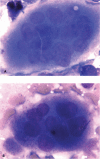Necessity of adjuvant postoperative radiotherapy for diffuse pigmented villonodular synovitis of the knee: A case report and literature review
- PMID: 29504995
- PMCID: PMC5779764
- DOI: 10.1097/MD.0000000000009637
Necessity of adjuvant postoperative radiotherapy for diffuse pigmented villonodular synovitis of the knee: A case report and literature review
Abstract
Rationale: Pigmented villonodular synovitis (PVNS) is an idiopathic, proliferative disorder lesion of synovial tissue, which is regarded as a benign disease, but has a local invasion. Up to now, these are no consensus about the etiology and pathogenesis of PVNS. Because of the lack of typical clinical features, misdiagnosis and delayed diagnosis are not uncommon, magnetic resonance imaging (MRI) can assist diagnosis and histopathological examination is recognized as the gold standard for the final diagnosis. Because this disease is so rare, there is no standard treatment. Surgical resection of the lesion is considered the preferred treatment, but postoperative recurrence is a problem that cannot be ignored. Postoperative radiotherapy is necessary, especially for patients with diffuse PVNS of the knee.
Patient concerns: A 27-year-old female teacher presented with 3 years chronic pain of the right knee, and progressive swelling aggravated for 1 week. The range of motion of the knee was limited.
Diagnoses: Clinical and laboratory examination failed to provide definitive diagnosis. Imaging can assist in diagnosis, and pathology is the gold standard. Erythrocyte sedimentation rate (ESR), antihemolytic streptococcus O (ASO), and rheumatoid factors (RF) were all negative. Joint puncture revealed giant cell tumor of the synovial membrane. PVNS was confirmed by postoperative pathology. The characteristic T2 weighted low signal of MRI suggests the recurrence of PVNS.
Interventions: The patient underwent 2 stages of treatment: open synovectomy was performed in the first place and postoperative external radiotherapy was not considered. After 2 years of disease-free remission, she was diagnosed with a recurrence of the disease by MRI. Further, arthroscopic total synovectomy of the right knee was performed and external beam radiotherapy was carried out after the operation.
Outcomes: Up to now, the patient was followed up for 3 years without any sign of recurrence.
Lessons: Adjuvant postoperative radiotherapy can improve the local control rate, it is a reliable treatment method for diffused PVNS.
Copyright © 2017 The Authors. Published by Wolters Kluwer Health, Inc. All rights reserved.
Conflict of interest statement
The authors have no conflicts of interest to disclose.
Figures




Similar articles
-
Recurrence of pigmented villonodular synovitis of the knee: A case report with review of literature on the risk factors causing recurrence.Medicine (Baltimore). 2020 Apr;99(16):e19856. doi: 10.1097/MD.0000000000019856. Medicine (Baltimore). 2020. PMID: 32312009 Free PMC article. Review.
-
Pigmented villonodular synovitis (PVNS) of the knee joint: magnetic resonance imaging (MRI) using standard and dynamic paramagnetic contrast media. Report of 52 cases surgically and histologically controlled.Radiol Med. 2004 Apr;107(4):356-66. Radiol Med. 2004. PMID: 15103287 English, Italian.
-
Combined partial arthroscopic synovectomy and radiation therapy for diffuse pigmented villonodular synovitis of the knee.Arthroscopy. 2001 May;17(5):527-31. doi: 10.1053/jars.2001.24068. Arthroscopy. 2001. PMID: 11337722
-
[Rheumatoid arthritis combined with pigmented villonodular synovitis: A case report and literature review].Beijing Da Xue Xue Bao Yi Xue Ban. 2020 Dec 18;52(6):1135-1139. doi: 10.19723/j.issn.1671-167X.2020.06.025. Beijing Da Xue Xue Bao Yi Xue Ban. 2020. PMID: 33331327 Free PMC article. Chinese.
-
Pigmented villonodular synovitis of the ankle-radiation therapy as a primary treatment to reduce recurrence: a case report with 8-year follow-up.J Foot Ankle Surg. 2011 Jan-Feb;50(1):108-16. doi: 10.1053/j.jfas.2010.10.001. J Foot Ankle Surg. 2011. PMID: 21172644 Review.
Cited by
-
Anlotinib Combined with Cranial Radiotherapy for Non-Small Cell Lung Cancer Patients with Brain Metastasis: A Retrospectively, Control Study.Cancer Manag Res. 2021 Aug 4;13:6101-6111. doi: 10.2147/CMAR.S319650. eCollection 2021. Cancer Manag Res. 2021. PMID: 34377028 Free PMC article.
-
Recurrence of pigmented villonodular synovitis of the knee: A case report with review of literature on the risk factors causing recurrence.Medicine (Baltimore). 2020 Apr;99(16):e19856. doi: 10.1097/MD.0000000000019856. Medicine (Baltimore). 2020. PMID: 32312009 Free PMC article. Review.
-
Diagnosis and Treatment Options in Pigmented Villonodular Synovitis of the Knee: A Narrative Review.J Clin Med. 2025 Aug 19;14(16):5857. doi: 10.3390/jcm14165857. J Clin Med. 2025. PMID: 40869683 Free PMC article. Review.
-
Arthroscopic Treatment of Pigmented Villonodular Synovitis of the Elbow.Case Rep Orthop. 2022 Oct 13;2022:7956167. doi: 10.1155/2022/7956167. eCollection 2022. Case Rep Orthop. 2022. PMID: 36277026 Free PMC article.
-
KRAS mutant tenosynovial giant cell tumor in a pediatric patient: a case report.Transl Pediatr. 2019 Dec;8(5):449-454. doi: 10.21037/tp.2019.11.05. Transl Pediatr. 2019. PMID: 31993359 Free PMC article.
References
-
- Myers BW, Masi AT. Pigmented villonodular synovitis and tenosynovitis: a clinical epidemiologic study of 166 cases and literature review. Medicine 1980;59:223–38. - PubMed
-
- Granowitz SP, D’Antonio J, Mankin HL. The pathogenesis and long-term end results of pigmented villonodular synovitis. Clin Orthop Relat Res 1976;114:335–51. - PubMed
-
- Ogilvie-Harris DJ, McLean J, Zarnett ME. Pigmented villonodular synovitis of the knee. The results of total arthroscopic synovectomy, partial, arthroscopic synovectomy, and arthroscopic local excision. J Bone Joint Surg Am 1992;74:119–23. - PubMed
-
- Zvijac JE, Lau AC, Hechtman KS, et al. Arthroscopic treatment of pigmented villonodular synovitis of the knee. Arthroscopy 1999;15:613–7. - PubMed
Publication types
MeSH terms
LinkOut - more resources
Full Text Sources
Other Literature Sources
Miscellaneous

